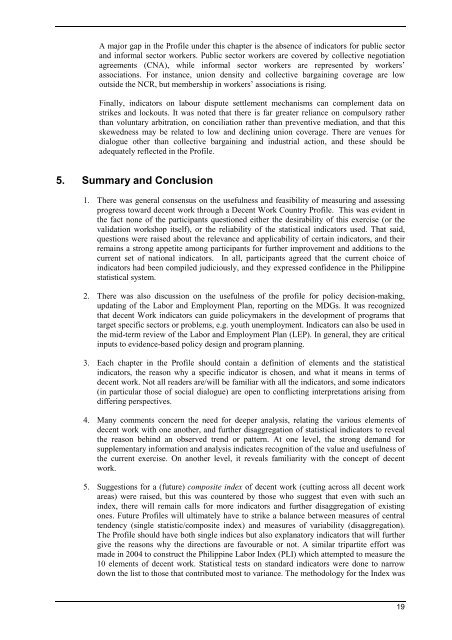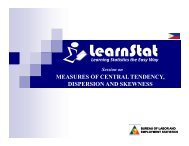Tripartite Validation Workshop of the Philippines Decent Work ...
Tripartite Validation Workshop of the Philippines Decent Work ...
Tripartite Validation Workshop of the Philippines Decent Work ...
Create successful ePaper yourself
Turn your PDF publications into a flip-book with our unique Google optimized e-Paper software.
A major gap in <strong>the</strong> Pr<strong>of</strong>ile under this chapter is <strong>the</strong> absence <strong>of</strong> indicators for public sector<br />
and informal sector workers. Public sector workers are covered by collective negotiation<br />
agreements (CNA), while informal sector workers are represented by workers’<br />
associations. For instance, union density and collective bargaining coverage are low<br />
outside <strong>the</strong> NCR, but membership in workers’ associations is rising.<br />
Finally, indicators on labour dispute settlement mechanisms can complement data on<br />
strikes and lockouts. It was noted that <strong>the</strong>re is far greater reliance on compulsory ra<strong>the</strong>r<br />
than voluntary arbitration, on conciliation ra<strong>the</strong>r than preventive mediation, and that this<br />
skewedness may be related to low and declining union coverage. There are venues for<br />
dialogue o<strong>the</strong>r than collective bargaining and industrial action, and <strong>the</strong>se should be<br />
adequately reflected in <strong>the</strong> Pr<strong>of</strong>ile.<br />
5. Summary and Conclusion<br />
1. There was general consensus on <strong>the</strong> usefulness and feasibility <strong>of</strong> measuring and assessing<br />
progress toward decent work through a <strong>Decent</strong> <strong>Work</strong> Country Pr<strong>of</strong>ile. This was evident in<br />
<strong>the</strong> fact none <strong>of</strong> <strong>the</strong> participants questioned ei<strong>the</strong>r <strong>the</strong> desirability <strong>of</strong> this exercise (or <strong>the</strong><br />
validation workshop itself), or <strong>the</strong> reliability <strong>of</strong> <strong>the</strong> statistical indicators used. That said,<br />
questions were raised about <strong>the</strong> relevance and applicability <strong>of</strong> certain indicators, and <strong>the</strong>ir<br />
remains a strong appetite among participants for fur<strong>the</strong>r improvement and additions to <strong>the</strong><br />
current set <strong>of</strong> national indicators. In all, participants agreed that <strong>the</strong> current choice <strong>of</strong><br />
indicators had been compiled judiciously, and <strong>the</strong>y expressed confidence in <strong>the</strong> Philippine<br />
statistical system.<br />
2. There was also discussion on <strong>the</strong> usefulness <strong>of</strong> <strong>the</strong> pr<strong>of</strong>ile for policy decision-making,<br />
updating <strong>of</strong> <strong>the</strong> Labor and Employment Plan, reporting on <strong>the</strong> MDGs. It was recognized<br />
that decent <strong>Work</strong> indicators can guide policymakers in <strong>the</strong> development <strong>of</strong> programs that<br />
target specific sectors or problems, e.g. youth unemployment. Indicators can also be used in<br />
<strong>the</strong> mid-term review <strong>of</strong> <strong>the</strong> Labor and Employment Plan (LEP). In general, <strong>the</strong>y are critical<br />
inputs to evidence-based policy design and program planning.<br />
3. Each chapter in <strong>the</strong> Pr<strong>of</strong>ile should contain a definition <strong>of</strong> elements and <strong>the</strong> statistical<br />
indicators, <strong>the</strong> reason why a specific indicator is chosen, and what it means in terms <strong>of</strong><br />
decent work. Not all readers are/will be familiar with all <strong>the</strong> indicators, and some indicators<br />
(in particular those <strong>of</strong> social dialogue) are open to conflicting interpretations arising from<br />
differing perspectives.<br />
4. Many comments concern <strong>the</strong> need for deeper analysis, relating <strong>the</strong> various elements <strong>of</strong><br />
decent work with one ano<strong>the</strong>r, and fur<strong>the</strong>r disaggregation <strong>of</strong> statistical indicators to reveal<br />
<strong>the</strong> reason behind an observed trend or pattern. At one level, <strong>the</strong> strong demand for<br />
supplementary information and analysis indicates recognition <strong>of</strong> <strong>the</strong> value and usefulness <strong>of</strong><br />
<strong>the</strong> current exercise. On ano<strong>the</strong>r level, it reveals familiarity with <strong>the</strong> concept <strong>of</strong> decent<br />
work.<br />
5. Suggestions for a (future) composite index <strong>of</strong> decent work (cutting across all decent work<br />
areas) were raised, but this was countered by those who suggest that even with such an<br />
index, <strong>the</strong>re will remain calls for more indicators and fur<strong>the</strong>r disaggregation <strong>of</strong> existing<br />
ones. Future Pr<strong>of</strong>iles will ultimately have to strike a balance between measures <strong>of</strong> central<br />
tendency (single statistic/composite index) and measures <strong>of</strong> variability (disaggregation).<br />
The Pr<strong>of</strong>ile should have both single indices but also explanatory indicators that will fur<strong>the</strong>r<br />
give <strong>the</strong> reasons why <strong>the</strong> directions are favourable or not. A similar tripartite effort was<br />
made in 2004 to construct <strong>the</strong> Philippine Labor Index (PLI) which attempted to measure <strong>the</strong><br />
10 elements <strong>of</strong> decent work. Statistical tests on standard indicators were done to narrow<br />
down <strong>the</strong> list to those that contributed most to variance. The methodology for <strong>the</strong> Index was<br />
19



